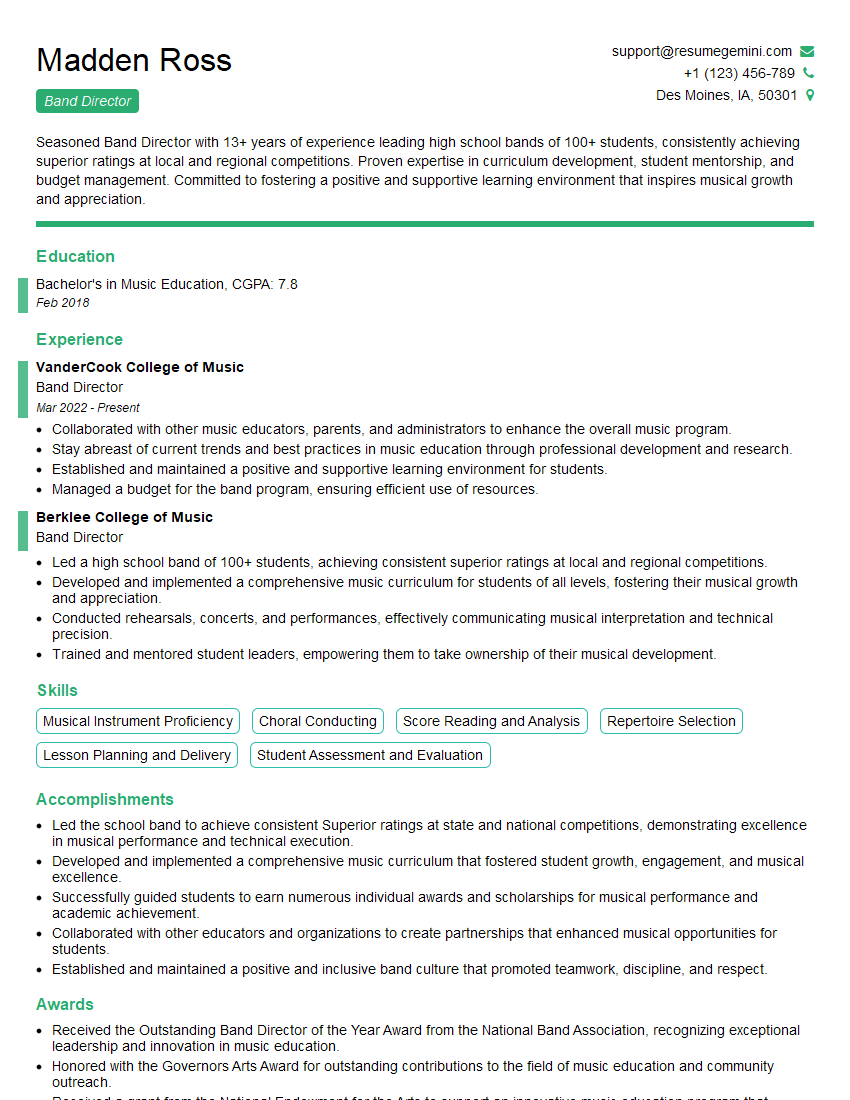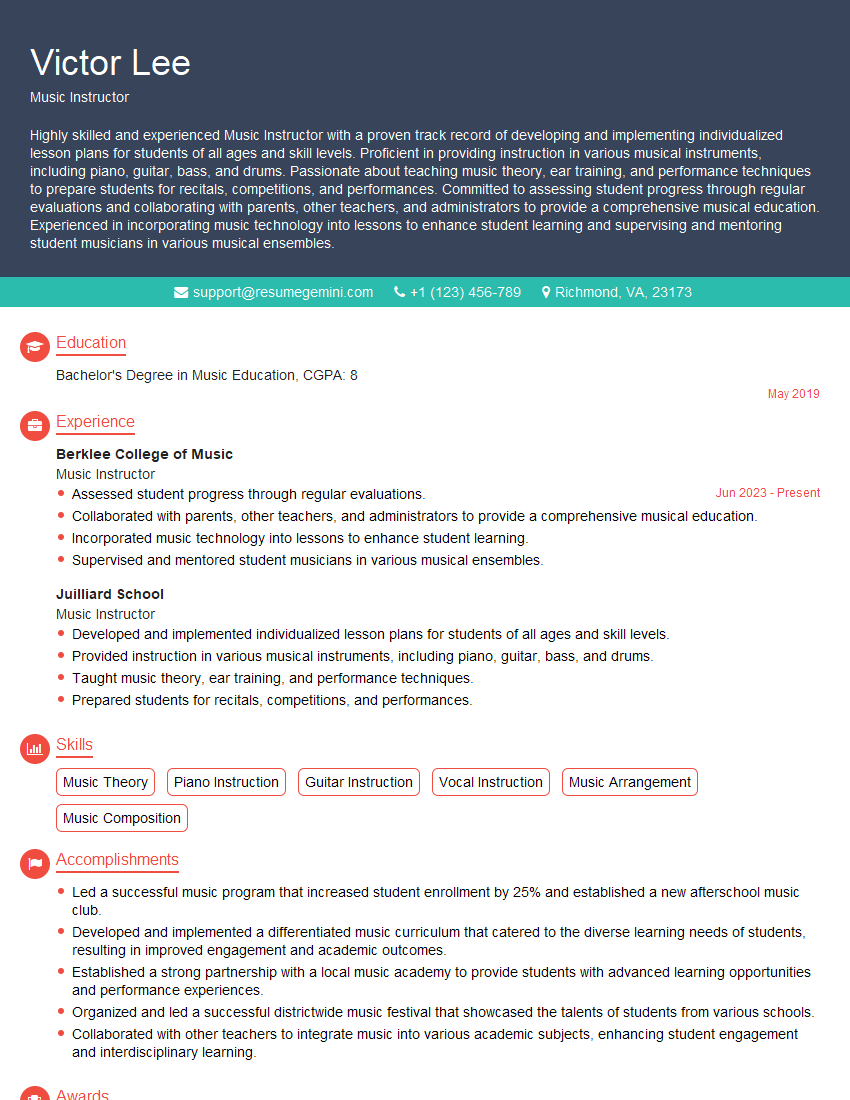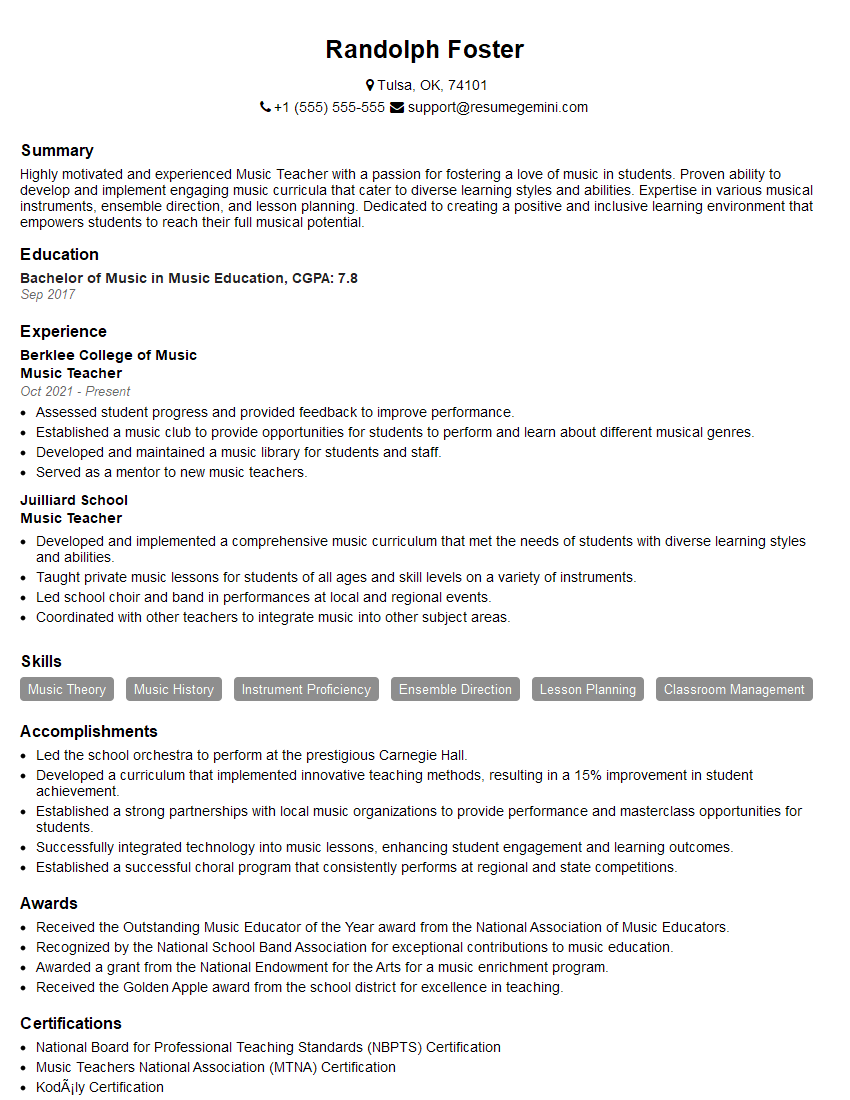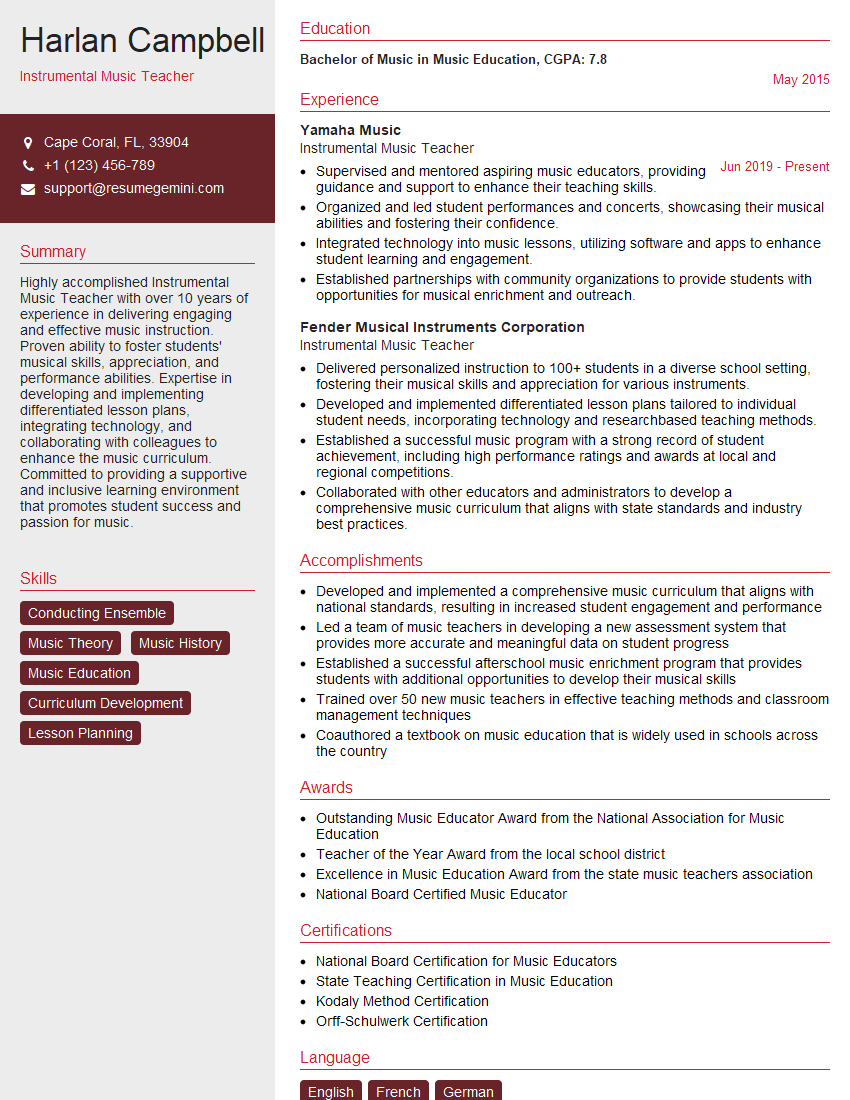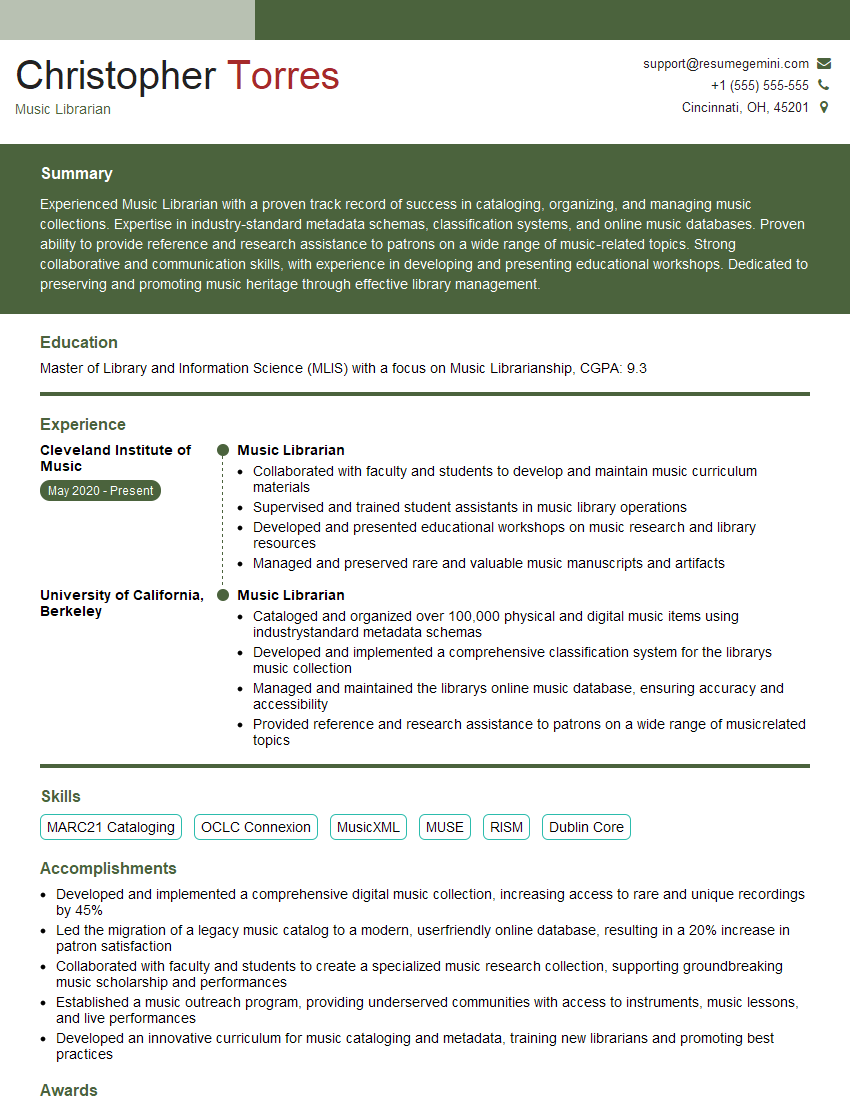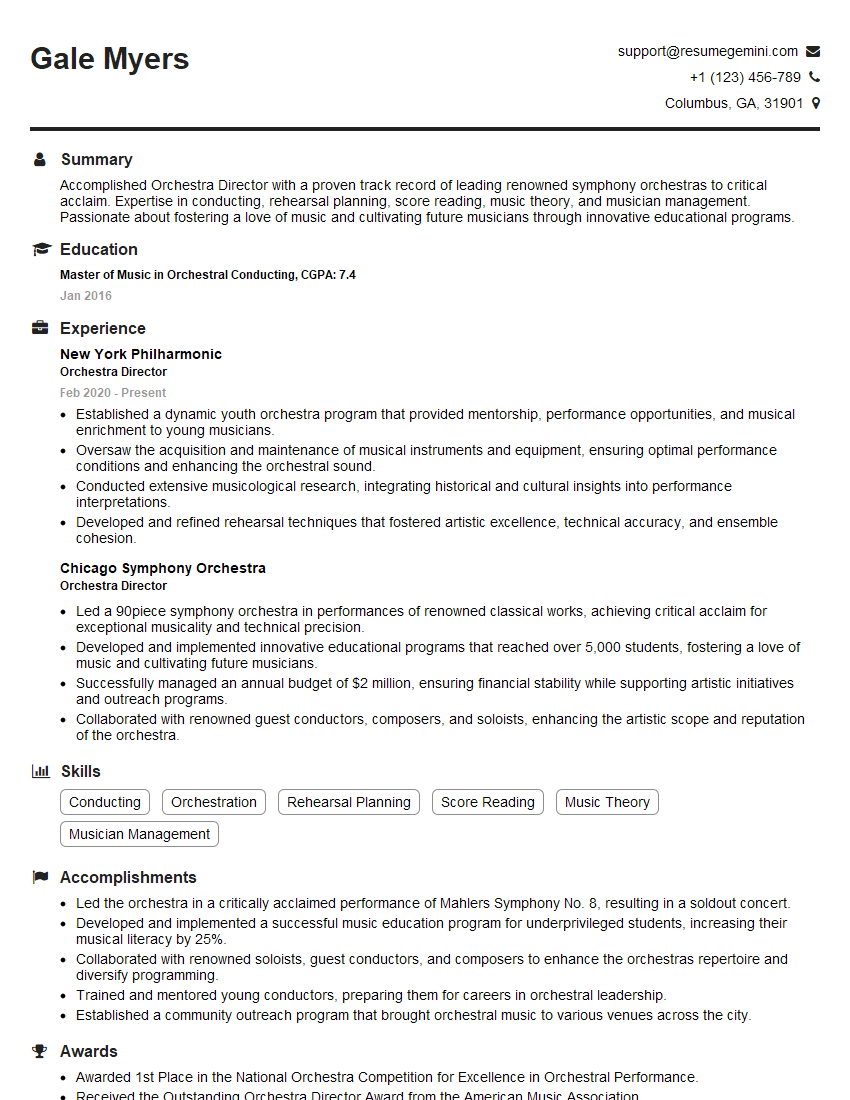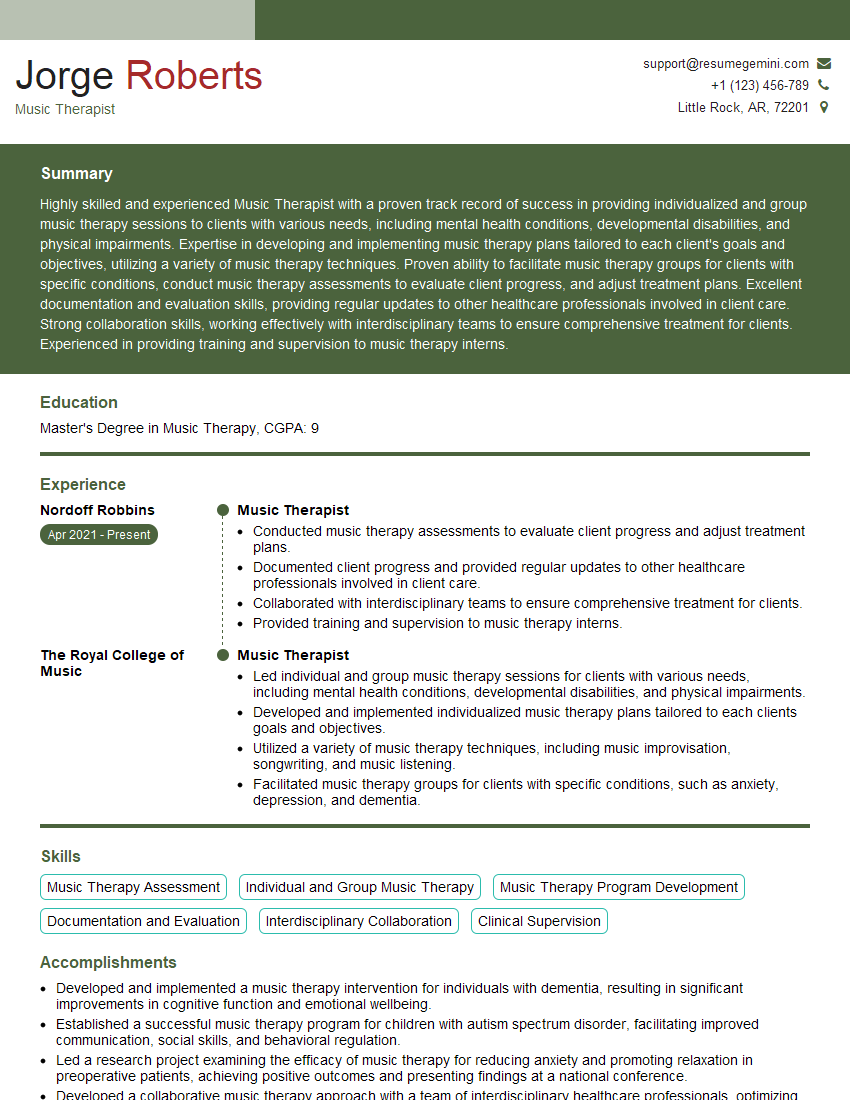Unlock your full potential by mastering the most common Music Education and Mentorship interview questions. This blog offers a deep dive into the critical topics, ensuring you’re not only prepared to answer but to excel. With these insights, you’ll approach your interview with clarity and confidence.
Questions Asked in Music Education and Mentorship Interview
Q 1. Describe your teaching philosophy for music education.
My teaching philosophy centers on fostering a lifelong love of music. I believe music education should be engaging, inclusive, and relevant to students’ lives. It’s not just about technical proficiency; it’s about developing creativity, critical thinking, collaboration, and self-expression. My approach emphasizes a balance between structured learning and exploration, allowing students to discover their own musical voices while mastering fundamental skills. I strive to create a supportive and encouraging environment where students feel safe to take risks, make mistakes, and learn from them. This includes celebrating both individual and collective achievements and focusing on the process of learning as much as the product.
For example, instead of solely focusing on perfect note execution, I might incorporate improvisation exercises to encourage creativity and develop aural skills. This fosters self-expression and ownership of their musical journey, making the learning process intrinsically motivating.
Q 2. What methods do you use to assess student progress in music?
Assessing student progress involves a multifaceted approach that goes beyond traditional tests. I utilize a combination of methods to gain a holistic understanding of each student’s development. This includes:
- Formal Assessments: Written tests on music theory, history, or composition, depending on the level and curriculum.
- Performance Evaluations: Recitals, concerts, and smaller performances which allow for evaluation of technique, musicality, and stage presence.
- Observation of Class Participation: Observing students’ engagement in class activities, their interaction with peers, and their problem-solving skills during ensemble work.
- Portfolio Assessment: Collecting student work, including compositions, arrangements, analyses, and reflections, to showcase their growth over time. This could even include audio or video recordings of their progress.
- Self and Peer Assessment: Students learn to evaluate their own work and provide constructive feedback to peers, fostering self-awareness and collaborative skills.
The weighting of each assessment method depends on the specific learning objectives and the age/level of the students. For example, younger students might have a greater emphasis on informal observation and participation, while older students will have more formal assessments, such as written exams and performance evaluations. I also provide regular feedback to students throughout the learning process, not just at the end of a unit or term. This ensures continuous improvement and allows for timely adjustments to teaching strategies.
Q 3. How do you adapt your teaching to different learning styles?
Recognizing that students learn in diverse ways is crucial. I adapt my teaching methods to cater to different learning styles, employing a multi-sensory approach. I incorporate:
- Visual Learners: Use of charts, diagrams, videos, and graphic organizers to illustrate musical concepts. For example, using color-coded notation to explain rhythmic patterns.
- Auditory Learners: Frequent listening exercises, aural dictation, singing, and group improvisation sessions. I might focus on ear-training and rhythmic dictation exercises for this group.
- Kinesthetic Learners: Hands-on activities, such as using manipulatives to understand rhythm, creating musical games, and engaging in movement and dance related to musical concepts. I use movement and rhythm activities for reinforcing concepts and building muscle memory.
I also differentiate instruction by offering various learning materials and providing opportunities for students to express their understanding in different ways. Some students may excel at written assessments, while others prefer practical demonstrations or creative projects. I ensure all students have diverse avenues for showcasing their learning and feeling successful. For example, a student might present their understanding of a piece through an analysis paper, a performance, or a visual representation.
Q 4. Explain your experience creating and implementing a music curriculum.
My experience in curriculum development involves a detailed and iterative process. I begin by defining clear learning objectives aligned with national or state standards, ensuring a balance between theoretical knowledge and practical application. For example, a curriculum might aim to develop students’ ability to sight-read music while also fostering their understanding of music theory and history.
Next, I select appropriate learning materials and resources, balancing textbook work with hands-on activities, technology integration, and real-world musical experiences. I also consider the students’ age, prior musical knowledge, and learning styles. I build in opportunities for differentiated instruction and assessment at each stage. Finally, I implement the curriculum, regularly assessing its effectiveness and making adjustments as needed based on student feedback and performance data. This could involve modifying activities, re-sequencing lessons, or adding supplementary materials. I document my adaptations meticulously so future implementations of the curriculum can benefit from these insights. In one instance, I noticed students struggling with a specific aspect of music theory, so I incorporated more interactive games and visual aids to clarify the concept and increased practice time. This resulted in significantly improved understanding in the following assessments.
Q 5. How do you manage classroom behavior and maintain a positive learning environment?
Maintaining a positive and productive learning environment is paramount. My approach focuses on proactive strategies to prevent disruptive behavior and foster a sense of community. This includes establishing clear expectations and classroom rules collaboratively with students, ensuring they understand the ‘why’ behind these rules. I also employ positive reinforcement techniques, celebrating successes both individually and collectively, and creating opportunities for students to take ownership of their learning.
When disruptive behaviors occur, I address them promptly and fairly, using restorative justice practices rather than punitive measures. This involves focusing on repairing harm and helping students understand the impact of their actions. I build relationships with students, demonstrating genuine care and understanding, creating an environment where students feel respected and safe to express themselves. Open communication channels with parents also play a crucial role in supporting students’ well-being and academic success. For example, using a ‘classroom contract’ co-created by the teacher and students empowers them and builds a sense of responsibility for the classroom’s success.
Q 6. What strategies do you use to differentiate instruction for students with varying abilities?
Differentiation for students with varying abilities is essential for inclusive music education. I use several strategies to ensure all students are challenged and supported appropriately. This involves:
- Tiered Assignments: Providing different levels of complexity for assignments, allowing students to work at their own pace and choose tasks that match their abilities. For example, in a composition assignment, some students might create a simple melody, while others might compose a more complex piece with multiple sections.
- Flexible Grouping: Using a mix of whole-class instruction, small group work, and individual learning time to cater to different learning styles and paces. Some lessons might be whole-class, while others will lend themselves to differentiated small group work.
- Assistive Technology: Utilizing assistive technology, such as note-reading software or adaptive instruments, to support students with specific learning needs. Consider providing options such as large print music, audio recordings, or assistive technology for music notation and performance.
- Modified Assessments: Adjusting assessment methods to accommodate different learning needs. This might involve providing extra time, allowing alternative methods of demonstrating understanding, or simplifying assessment tasks.
The key is to ensure that all students have access to the curriculum and feel supported in their learning journey. I regularly monitor student progress and adapt my instruction accordingly to meet their individual needs. This includes regular check-ins and one-on-one conversations to understand challenges and build confidence.
Q 7. How do you incorporate technology into your music education?
Technology plays a significant role in enhancing my music education practice. I use technology to:
- Enhance Learning: Employing music software such as GarageBand, Logic Pro X, or Sibelius for composition, arranging, and music production. Using notation software like MuseScore makes creating and sharing scores easier.
- Expand Access to Music: Utilizing online resources such as YouTube, educational websites (e.g., online music theory courses), and streaming services to access a vast library of musical works and educational materials. This broadens students’ musical horizons.
- Promote Collaboration: Using collaborative platforms for projects, allowing students to work together remotely on compositions, arrangements, or research projects. Google Docs or collaborative online whiteboards are excellent tools for this.
- Enhance Performance: Utilizing digital audio workstations (DAWs) for recording and mixing performances, enhancing student confidence by creating professional-quality recordings. This is invaluable for showcases and portfolio development.
- Increase Engagement: Integrating interactive music games and apps to make learning more fun and engaging. Many such apps exist for practicing scales, rhythm, and music theory concepts.
However, I am mindful of balancing technology use with hands-on learning and human interaction. Technology is a valuable tool, but it should not replace the core elements of music education, like live performance and collaborative ensemble work.
Q 8. Describe your experience working with students from diverse backgrounds.
Working with students from diverse backgrounds is a cornerstone of my teaching philosophy. I believe that music transcends cultural boundaries, and my approach centers on celebrating the unique perspectives and experiences each student brings to the classroom. This involves actively listening to their stories, understanding their musical traditions, and adapting my teaching methods to accommodate different learning styles and needs.
For example, in one class, I had students from various ethnic backgrounds, each familiar with different musical instruments and genres. Instead of imposing a single curriculum, we explored each student’s musical heritage through presentations, performances, and collaborative projects. This fostered a sense of mutual respect and enriched the learning experience for everyone. I also make sure to use inclusive language and materials, and actively seek out resources that represent the diverse musical landscape.
- Adapting teaching styles: Recognizing that visual, auditory, and kinesthetic learners respond differently, I incorporate a variety of teaching methods, from lectures and discussions to hands-on activities and group projects.
- Culturally responsive teaching: I integrate diverse musical styles and traditions into the curriculum, fostering an inclusive and enriching learning environment.
- Building relationships: Creating a safe and supportive classroom environment where students feel comfortable sharing their experiences and perspectives is crucial.
Q 9. How do you foster creativity and self-expression in your students?
Fostering creativity and self-expression is at the heart of effective music education. I achieve this through a combination of structured learning and open-ended exploration. I encourage students to experiment with different musical ideas, to take risks, and to develop their own unique voices.
I start by providing a foundation in music theory and technique, but then I create opportunities for improvisation, composition, and arrangement. For example, we might have ‘jam sessions’ where students improvise melodies over a given chord progression, or they might compose their own short pieces based on a specific theme or emotion. I also encourage students to explore different genres and styles of music, broadening their creative horizons. Regular feedback and constructive criticism are crucial in helping students develop their creative potential. I often use prompts like, ‘What story does this music tell?’ or ‘How can you evoke a specific feeling through your composition?’ to inspire their creative exploration.
- Improvisation exercises: Improvisation helps students develop their musical ear and allows for spontaneous self-expression.
- Composition projects: Composing their own music gives students a chance to translate their ideas into tangible musical works.
- Open-ended assignments: Assignments that allow for creative freedom encourage innovation and unique musical voices.
Q 10. Explain your approach to teaching music theory and its application.
My approach to teaching music theory is deeply intertwined with its practical application. I believe that music theory shouldn’t be a dry, abstract subject but a tool that empowers students to understand and create music more effectively. I avoid rote memorization and instead focus on understanding the underlying principles.
We start with the basics – rhythm, melody, harmony – but I constantly relate these concepts to real-world examples from the music they listen to and play. For instance, when learning about major and minor scales, we analyze pieces from different genres to hear how these scales create distinct moods. Similarly, studying chord progressions involves exploring how they function in different songs and styles. I encourage students to actively apply their knowledge through composition, arranging, and analysis projects. This active approach ensures they don’t just understand the theory but can also utilize it creatively.
- Real-world application: Constantly connecting theoretical concepts to practical musical examples.
- Active learning: Engaging students in composition, arranging, and analytical exercises.
- Collaborative learning: Encouraging peer teaching and group analysis of musical works.
Q 11. How do you incorporate performance opportunities into your curriculum?
Performance opportunities are integral to my curriculum. They’re not just a showcase of skills but a crucial element of learning and growth. I believe that performing allows students to apply their knowledge, build confidence, and experience the joy of sharing their music with others.
We organize regular class performances, incorporating various formats. This includes informal recitals, where students can perform pieces they’ve been working on, and more formal concerts, involving collaborative ensemble performances. We also participate in local music festivals and competitions, providing students with valuable experience in performing for a wider audience. The planning and preparation process for these performances are just as important as the performances themselves. Students learn about stage presence, collaboration, and time management.
- Regular class performances: Provides opportunities for frequent application and feedback.
- Formal concerts and festivals: Offers experience in performing for larger audiences.
- Collaborative ensembles: Encourages teamwork and shared musical experiences.
Q 12. What techniques do you use to build student confidence and motivation?
Building student confidence and motivation is paramount. I approach this through a multifaceted strategy focused on creating a supportive learning environment, celebrating achievements, and providing individualized support.
I foster a positive classroom atmosphere where mistakes are seen as opportunities for learning. I provide regular, constructive feedback emphasizing strengths while offering specific suggestions for improvement. I also celebrate both individual and group achievements through awards, informal acknowledgements, and public recognition. For students struggling with motivation, I work closely with them to identify their strengths, set achievable goals, and find ways to make the learning process more engaging. I often adapt assignments to suit individual learning styles and paces.
- Positive reinforcement: Celebrating achievements and effort.
- Individualized support: Addressing the specific needs of each student.
- Growth mindset: Emphasizing learning and improvement over perfection.
Q 13. Describe your experience in providing feedback to students.
Providing feedback is a crucial aspect of my role. It’s not just about identifying errors but about guiding students towards improvement and fostering their musical growth. My feedback is always constructive, specific, and delivered in a supportive manner.
I focus on both the technical aspects of their performance – accuracy, rhythm, tone – and the expressive qualities – phrasing, dynamics, emotion. I use a combination of verbal feedback, written comments, and modeling to illustrate points. For instance, instead of simply saying ‘your rhythm was off,’ I might say ‘in measure 7, your eighth notes were slightly rushed; let’s try playing them with a more even beat.’ I always balance criticism with praise, focusing on what the student did well, before offering suggestions for improvement.
- Specific and constructive: Focusing on concrete examples and offering actionable suggestions.
- Balanced approach: Combining positive reinforcement with constructive criticism.
- Multiple modes of feedback: Using verbal, written, and demonstrated feedback.
Q 14. How do you handle conflict or challenging situations in the classroom?
Handling conflict or challenging situations requires a calm, proactive, and empathetic approach. My aim is to address the underlying issue while fostering a respectful classroom environment.
I typically start by listening carefully to all parties involved, seeking to understand their perspectives. I try to create a safe space where students feel comfortable expressing their concerns without fear of judgment. Once I understand the situation, I work collaboratively with the students to find a solution that is fair and equitable. Sometimes this might involve mediation, conflict resolution techniques, or adjusting classroom procedures. In more serious cases, I might involve parents or school administration, but I always prioritize open communication and a restorative approach. Proactive strategies like establishing clear classroom rules and expectations, and fostering a strong sense of community, can often prevent conflicts from arising in the first place.
- Active listening: Understanding all perspectives involved in the conflict.
- Collaborative problem-solving: Working with students to find mutually acceptable solutions.
- Preventive measures: Establishing clear expectations and fostering a positive classroom climate.
Q 15. How do you collaborate with parents and guardians to support student learning?
Collaboration with parents and guardians is crucial for a student’s holistic musical development. I believe in establishing open and transparent communication channels from the outset. This involves regular updates – perhaps a brief email after each lesson highlighting progress and areas for focus – and scheduled parent-teacher conferences.
During these conferences, I not only discuss the student’s technical skills but also their engagement, attitude, and overall progress. I actively seek parental input on the student’s practice habits at home, learning preferences, and any challenges they might be facing. For example, if a student is struggling with a particular piece, I might collaborate with the parents to find ways to make practice more engaging at home, perhaps by incorporating games or breaking down practice sessions into shorter, more manageable chunks.
Furthermore, I emphasize the importance of consistent practice and provide parents with practical strategies and resources to support their child’s musical journey. This collaborative approach ensures that the learning process extends beyond the classroom and fosters a supportive environment for the student’s growth. Open communication, mutual respect, and a shared goal of musical achievement are key to this partnership.
Career Expert Tips:
- Ace those interviews! Prepare effectively by reviewing the Top 50 Most Common Interview Questions on ResumeGemini.
- Navigate your job search with confidence! Explore a wide range of Career Tips on ResumeGemini. Learn about common challenges and recommendations to overcome them.
- Craft the perfect resume! Master the Art of Resume Writing with ResumeGemini’s guide. Showcase your unique qualifications and achievements effectively.
- Don’t miss out on holiday savings! Build your dream resume with ResumeGemini’s ATS optimized templates.
Q 16. How do you assess the effectiveness of your teaching methods?
Assessing the effectiveness of my teaching methods is an ongoing process, not a single event. I use a multifaceted approach that combines formative and summative assessment techniques. Formative assessment involves ongoing monitoring of student progress throughout the learning process. This includes observing students during lessons, providing regular feedback on their performance, and using informal quizzes or short assignments to gauge their understanding of concepts.
Summative assessments, on the other hand, provide a more comprehensive evaluation of student learning at the end of a unit or a term. These might involve formal performances, written exams focusing on music theory, or the submission of compositions. Beyond these traditional methods, I also gather data through student self-assessments, where students reflect on their progress and identify areas for improvement. This provides valuable insights into their self-awareness and learning process.
Analyzing the data gathered from these different assessments helps me identify which teaching methods are effective and where adjustments might be needed. For instance, if students consistently struggle with a particular musical concept, I might revise my teaching approach to make it more engaging or accessible. This iterative process of assessment, analysis, and refinement ensures that my teaching remains relevant, effective, and responsive to the individual needs of my students.
Q 17. What are your professional development goals in music education?
My professional development goals in music education center around expanding my knowledge of diverse musical styles and pedagogical approaches. I aim to deepen my understanding of inclusive music education practices, ensuring that all students, regardless of their background or abilities, have equal opportunities to participate and excel.
Specifically, I am interested in exploring innovative technologies for music education, such as music notation software and online learning platforms. I also want to enhance my skills in curriculum design and development, crafting engaging and effective lesson plans that cater to diverse learning styles. Furthermore, I plan to engage in research and explore best practices in music education by attending workshops, conferences, and pursuing relevant professional development courses. Ultimately, my goal is to continually refine my skills and knowledge to provide the highest quality music education to my students.
Q 18. Describe your experience mentoring students outside of formal instruction.
My experience mentoring students outside of formal instruction has been immensely rewarding. I’ve worked with several students individually, helping them prepare for auditions, competitions, or simply fostering their love for music beyond the classroom setting. One example involves a young student who was struggling with stage fright. Through regular informal sessions focused on breathing techniques, positive self-talk, and performance practice, we gradually built her confidence. We also focused on choosing repertoire that matched her skills and interests, empowering her to feel confident and successful.
Another example is a talented student who wanted to improve their improvisation skills. We worked together, exploring different scales and chord progressions, experimenting with different rhythmic and melodic ideas, and developing a more intuitive understanding of jazz harmony. These mentoring relationships are built on trust, mutual respect, and a shared passion for music. They provide a space for students to explore their musical potential without the pressures of formal assessment. I tailor my approach to each student’s unique needs and aspirations, acting as a guide and a supportive companion on their musical journey.
Q 19. How do you identify and nurture student talent?
Identifying and nurturing student talent involves a keen observation of their natural abilities and a conscious effort to foster their potential. I look for students who demonstrate a strong passion for music, a willingness to learn, and a certain level of innate musicality. This might manifest as exceptional rhythmic accuracy, an intuitive understanding of melody, or an exceptional ear for pitch. But talent is not just about natural aptitude; it also involves hard work, dedication, and perseverance.
Nurturing talent requires providing students with challenging yet achievable goals. I do this by introducing them to increasingly complex pieces or musical concepts, tailoring the curriculum to their individual abilities, and pushing them gently outside their comfort zones. Regular feedback, both positive reinforcement and constructive criticism, plays a vital role. Creating opportunities for performance, whether it’s a small recital or a school concert, allows students to showcase their talent, receive validation for their efforts, and develop their performance skills. Encouraging participation in ensembles and workshops also provides invaluable learning experiences and opportunities for collaboration.
Q 20. What strategies do you employ to foster collaboration among students?
Fostering collaboration among students is essential for creating a vibrant and supportive learning environment. I use a variety of strategies to encourage teamwork and mutual learning. One effective technique is group projects, where students work collaboratively on compositions, arranging pieces, or creating musical presentations. This requires them to communicate effectively, negotiate ideas, and learn to value each other’s contributions.
Ensemble participation is another powerful tool for building collaboration. Whether it’s a choir, orchestra, or band, students learn to listen to each other, synchronize their performances, and contribute to a shared musical outcome. I also incorporate peer teaching into my lessons, where students explain concepts to one another or assist each other with practice. This not only strengthens their understanding but also promotes empathy and mutual support. Creating a classroom culture that values collaboration, celebrates diversity, and encourages mutual respect is crucial for fostering a positive and productive learning environment.
Q 21. Describe your experience using various musical instruments and teaching techniques.
My experience with musical instruments spans various genres and teaching methodologies. I am proficient in playing the piano, guitar, and flute, and this allows me to demonstrate techniques and provide accompaniment during lessons. I employ a variety of teaching techniques tailored to individual student needs and learning styles. For example, I use the Kodály method which emphasizes singing and movement to develop aural skills and musical understanding. I also incorporate the Suzuki method, focusing on early childhood music education and fostering a nurturing learning environment.
For older students, I often utilize a more analytical approach, incorporating music theory and composition into the lessons. I believe in a blended approach where I use different teaching methods depending on the student’s age, learning style, and musical goals. My teaching philosophy is centered on creating a supportive, encouraging, and engaging learning environment where students feel empowered to explore their musical potential. I adapt my teaching style to different learning styles, using visual aids, auditory exercises, and kinesthetic activities to accommodate diverse learners. I always aim to make learning fun and rewarding, so students develop a lifelong love of music.
Q 22. How do you incorporate music history and cultural perspectives into your teaching?
Incorporating music history and cultural perspectives isn’t just about memorizing dates and names; it’s about understanding the context that shapes musical expression. I weave these elements into my teaching by making connections between historical events, social movements, and the music created during those periods. For example, when teaching about the Blues, we explore its origins in the hardships faced by African Americans during slavery and the post-Reconstruction era. We listen to various Blues artists, analyzing their musical styles and lyrics to understand the emotional depth and social commentary embedded within the music. Similarly, when studying Baroque music, we examine the societal structures and artistic patronage systems of the time and how those factors influenced the composition and performance of works by Bach or Handel. I use primary source materials whenever possible – recordings, images, and historical documents – to create a richer and more engaging learning experience. This approach helps students develop a deeper appreciation for music’s power to reflect and shape human experiences across cultures and time.
Q 23. What experience do you have with different musical genres and styles?
My experience spans a wide range of musical genres and styles, from classical and jazz to pop, rock, and world music. I’ve worked with students playing various instruments – strings, woodwinds, brass, percussion, and voice – across different musical traditions. My background includes extensive training in classical music, which provides a strong foundation in music theory and performance practices. However, I also have a deep passion for jazz improvisation, having performed in numerous jazz ensembles and workshops. This experience allows me to approach teaching from multiple perspectives, helping students understand the underlying principles that govern various musical styles while also embracing individual expression and creativity. For instance, I might use a pop song to illustrate a specific harmonic progression, or a jazz standard to demonstrate improvisation techniques, showing students that musical concepts transcend genre boundaries.
Q 24. Describe your experience with various assessment methods (e.g., rubrics, portfolios, performances).
I believe in utilizing a diverse range of assessment methods to gain a comprehensive understanding of each student’s progress. While traditional rubrics are useful for evaluating technical proficiency in performance or composition, they don’t always capture the creativity and expressive qualities of musical work. Therefore, I also incorporate portfolio assessments, where students showcase their work over time, demonstrating growth and development. Portfolios can include recordings of performances, written compositions, reflective journals, and program notes, allowing for a more holistic evaluation. Finally, live performances are crucial for assessing musicality, stage presence, and collaborative skills. I design performance assessments that are tailored to the students’ skill level and learning objectives, providing opportunities for students to showcase their strengths and areas for improvement. For instance, a younger student might present a simple solo performance, whereas an older student could participate in a more complex ensemble setting. Constructive feedback is provided after each assessment, focusing on both technical aspects and artistic interpretation.
Q 25. Explain your approach to managing student behavior during group rehearsals or performances.
Managing student behavior during rehearsals and performances requires a proactive and positive approach. I establish clear expectations from the beginning, emphasizing the importance of respect, focus, and collaboration. This includes developing classroom routines and procedures that are clear and consistent. Before rehearsals, I clearly outline the objectives and expectations for behavior and participation. During rehearsals, I address disruptive behavior promptly and fairly, using positive reinforcement to encourage good behavior. For example, acknowledging a student’s attentiveness or praising their efforts can be more effective than focusing solely on negative behaviors. When dealing with more serious issues, I take a restorative approach, working with the student individually to understand the underlying cause of the behavior and develop strategies for improvement. In performance settings, I provide opportunities for students to practice stage deportment and etiquette, fostering a sense of professionalism and responsibility.
Q 26. How do you adapt your teaching approach for different age groups?
My teaching approach adapts significantly based on the age group. With younger students, I emphasize play-based learning, using games and engaging activities to introduce musical concepts and develop basic skills. I employ a variety of colorful visuals, movement exercises, and storytelling to capture their attention and make learning fun. With older students, I incorporate more complex theoretical concepts and encourage independent learning and critical thinking. I foster their creative expression by providing opportunities for improvisation, composition, and exploring different musical styles. For adolescents, I emphasize the development of leadership and collaboration skills within ensembles. My communication style also shifts according to the age group; I use simpler language and more visual aids for younger children, whereas with older students, I engage in more in-depth discussions and encourage them to develop their own analytical skills. I also tailor the length and structure of lessons to the students’ attention spans and learning styles.
Q 27. What is your experience working with students who have learning disabilities or special needs?
I have extensive experience working with students who have learning disabilities or special needs. My approach is grounded in the principles of differentiation and inclusion. I create individualized learning plans that cater to each student’s unique needs and learning styles. This might involve adjusting the pace of instruction, providing alternative assessment methods, or using assistive technologies. For students with auditory processing challenges, I might use visual aids, such as notation software or color-coded charts. For students with motor skill difficulties, I might modify instrumental techniques or adapt physical activities. Collaboration with specialists, such as occupational therapists or special education teachers, is essential to ensure that I provide the most effective support. My focus is on building a positive and inclusive learning environment where all students feel valued and supported. Every student’s progress is celebrated, and I focus on their strengths and areas for growth rather than focusing solely on challenges.
Q 28. Describe your experience in using assistive technology to support student learning in music.
Assistive technology plays a crucial role in supporting students with disabilities in music education. I have experience utilizing various technologies, including music notation software (e.g., Sibelius, Finale), digital audio workstations (DAWs) (e.g., GarageBand, Ableton Live), and adaptive instruments. For students with visual impairments, screen readers and Braille displays can make notation software accessible. For students with motor impairments, assistive switches and adaptive controllers can enable interaction with musical instruments and software. DAWs can be particularly helpful in creating accessible learning materials. For example, I could create audio recordings with visual cues to help students with auditory processing challenges, or use visual aids to represent musical concepts in a more accessible format. The key is to identify the specific needs of the student and select the most appropriate technology to enhance their learning experience. Training and ongoing professional development in the use of assistive technology are crucial to maximize its effectiveness in my teaching.
Key Topics to Learn for Music Education and Mentorship Interview
- Curriculum Development & Pedagogical Approaches: Explore various teaching methodologies, adapting instruction for diverse learning styles, and creating engaging lesson plans tailored to different age groups and skill levels. Consider the application of different learning theories (e.g., constructivism, behaviorism) within a musical context.
- Assessment & Evaluation Techniques: Understand different methods for assessing student progress, including both formative and summative assessments. Discuss strategies for providing constructive feedback and creating a supportive learning environment. This includes practical application of rubrics and performance evaluation techniques.
- Classroom Management & Student Engagement: Develop strategies for maintaining a positive and productive learning environment. Discuss techniques for engaging students, addressing challenging behaviors, and fostering collaboration. Consider the unique challenges and rewards of working with diverse musical populations.
- Mentorship & Student Support: Explore the principles of effective mentorship, focusing on building strong relationships with students, providing guidance and support, and fostering their personal and musical growth. This includes addressing challenges in student performance, motivation, and overall wellbeing.
- Music Theory & History: Demonstrate a solid understanding of fundamental music theory concepts and historical periods. Be prepared to discuss how you integrate these into your teaching and mentorship. Consider your approach to teaching music history in a captivating manner.
- Technology Integration in Music Education: Discuss your experience and comfort level with using technology in the classroom. This could include music software, digital audio workstations (DAWs), online learning platforms, and other relevant technologies.
- Professional Development & Collaboration: Showcase your commitment to ongoing professional development and collaboration with colleagues. Discuss your participation in workshops, conferences, or professional organizations related to music education.
Next Steps
Mastering Music Education and Mentorship is crucial for a fulfilling and impactful career. It allows you to shape young musicians’ lives and contribute significantly to the arts community. To stand out, a strong, ATS-friendly resume is vital. ResumeGemini can help you craft a compelling and effective resume that showcases your unique skills and experience in Music Education and Mentorship. We provide examples of resumes tailored to this field to help guide you. Invest the time to build a resume that truly reflects your dedication and expertise – it’s your first impression with potential employers.
Explore more articles
Users Rating of Our Blogs
Share Your Experience
We value your feedback! Please rate our content and share your thoughts (optional).
What Readers Say About Our Blog
Hello,
We found issues with your domain’s email setup that may be sending your messages to spam or blocking them completely. InboxShield Mini shows you how to fix it in minutes — no tech skills required.
Scan your domain now for details: https://inboxshield-mini.com/
— Adam @ InboxShield Mini
Reply STOP to unsubscribe
Hi, are you owner of interviewgemini.com? What if I told you I could help you find extra time in your schedule, reconnect with leads you didn’t even realize you missed, and bring in more “I want to work with you” conversations, without increasing your ad spend or hiring a full-time employee?
All with a flexible, budget-friendly service that could easily pay for itself. Sounds good?
Would it be nice to jump on a quick 10-minute call so I can show you exactly how we make this work?
Best,
Hapei
Marketing Director
Hey, I know you’re the owner of interviewgemini.com. I’ll be quick.
Fundraising for your business is tough and time-consuming. We make it easier by guaranteeing two private investor meetings each month, for six months. No demos, no pitch events – just direct introductions to active investors matched to your startup.
If youR17;re raising, this could help you build real momentum. Want me to send more info?
Hi, I represent an SEO company that specialises in getting you AI citations and higher rankings on Google. I’d like to offer you a 100% free SEO audit for your website. Would you be interested?
Hi, I represent an SEO company that specialises in getting you AI citations and higher rankings on Google. I’d like to offer you a 100% free SEO audit for your website. Would you be interested?
good
